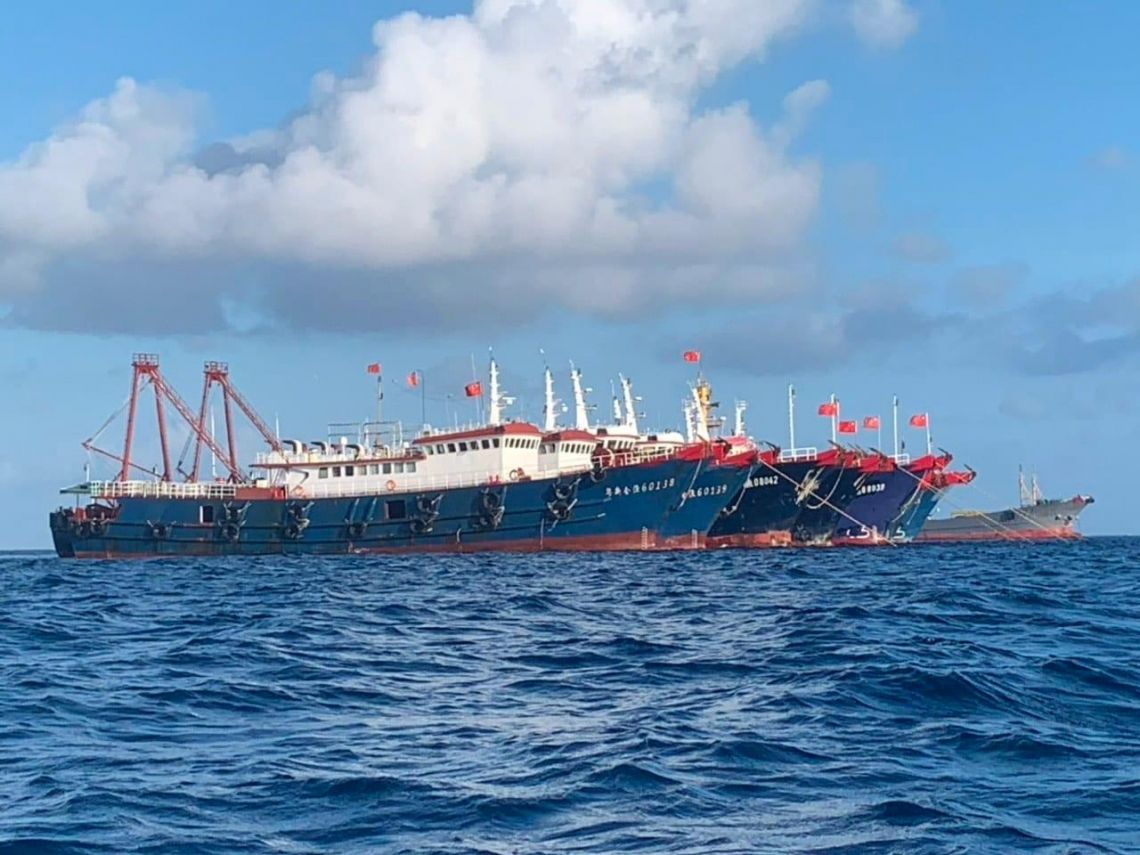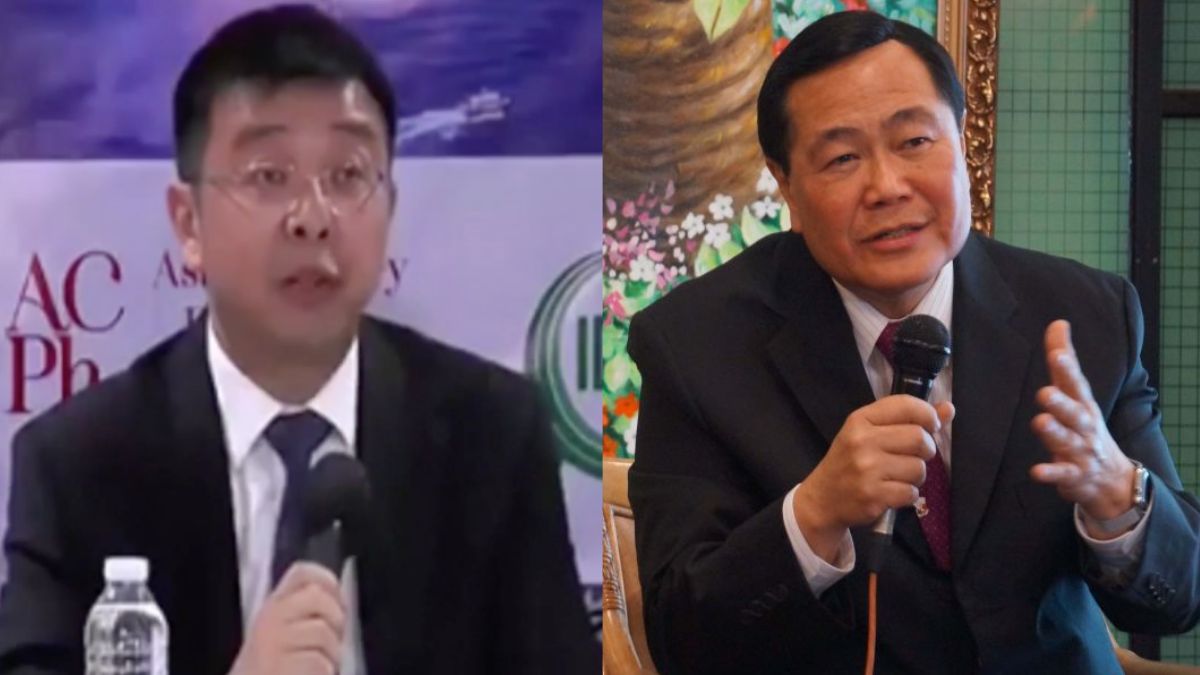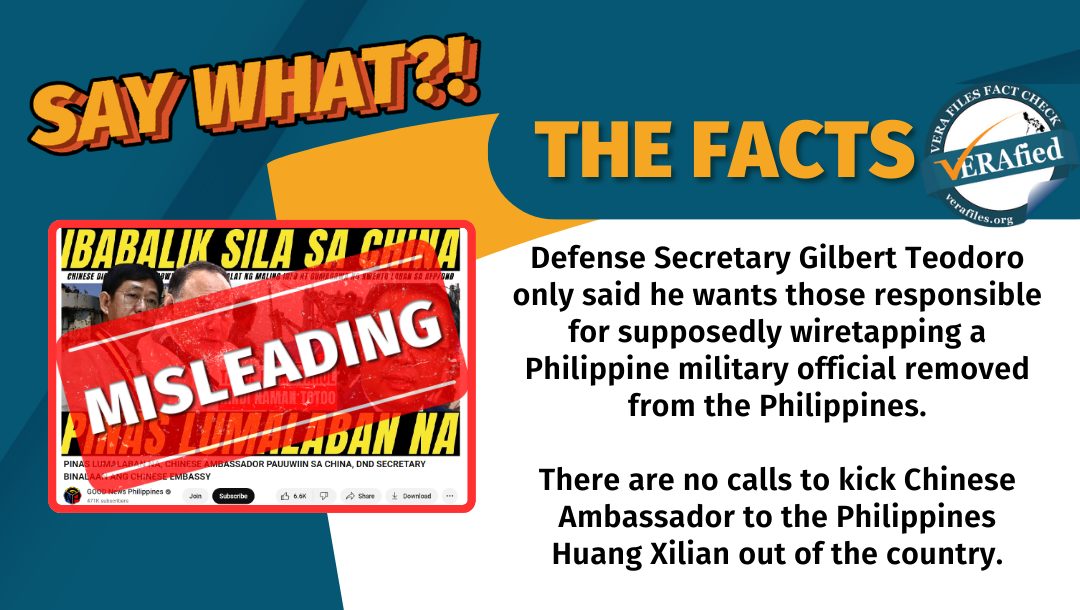The Chinese Embassy in Manila has reiterated Beijing’s false claim that Julian Felipe Reef (international name: Whitsun Reef) is part of China territory.
The statement runs counter to international law as well as to the 2016 ruling of the Permanent Court of Arbitration (PCA) in favor of the Philippines against China on the issue of disputed areas in the West Philippine Sea.
STATEMENT
In a statement on April 5, the Chinese Embassy reacted to an earlier statement by Defense Secretary Delfin Lorenzana calling out the continued presence of 44 Chinese vessels on Julian Felipe Reef, which China refers to as Niu’e Jiao.
Part of the statement read:
“The Niu’e Jiao is part of China’s Nansha Islands (internationally known as the Spratly Island Group). The waters around Niu’e Jiao has been a traditional fishing ground for Chinese fishermen for many years.”
Source: Chinese Embassy in Manila, Statement by Spokesperson of the Chinese Embassy (Archived), April 5, 2021
It further called Lorenzana’s remarks “perplexing” and “unprofessional,” and referred him to a March 22 statement of the embassy spokesperson on the same issue that likewise said, “Niu’e Jiao is part of China’s Nansha Qundao.”
FACT
Julian Felipe Reef, located around 324 kilometers or 175 nautical miles west of Bataraza town in Palawan province, is within the Philippines’ 200-nautical-mile exclusive economic zone (EEZ) in the South China Sea. It is approximately 638.23 nautical miles away from China’s Hainan Island.
It is part of the Kalayaan Island Group, which consists of more than 50 features and their surrounding waters in the Spratly Island Group, that falls under the jurisdiction of the Philippines.
An EEZ is an area “beyond and adjacent to the territorial sea” of a coastal state, like the Philippines, in which it has sovereign rights to explore, exploit, observe, and manage the natural resources, according to the United Nations Convention on the Law of the Sea (UNCLOS).
Both China and the Philippines are parties to UNCLOS. But China continues to assert its nine-dash line claim, which covers almost 80% of the entire South China Sea, including areas that fall under Philippine territory and EEZ (known as the West Philippine Sea).
(See VERA FILES FACT CHECK: Duterte says the name ‘South China Sea’ reflects China’s historical claim)
In its July 2016 decision on the South China Sea dispute, the PCA ruled that China’s claims to “historic rights, or other sovereign rights or jurisdiction” under its nine-dash line claim are:
“…contrary to [UNCLOS] and without lawful effect to the extent that they exceed the geographic and substantive limits of China’s maritime entitlements under the Convention.”
Source: Permanent Court of Arbitration, South China Sea Arbitration Award (p. 473), July 12, 2016
The tribunal added that UNCLOS “superseded any historic rights, or other sovereign rights or jurisdiction, in excess of the limits [it] imposed.”
BACKSTORY
The issue first reached the public on March 20, when the National Task Force for the West Philippine Sea said it received a “confirmed report” from the coast guard that “around 220 Chinese Maritime Militia Vessels [were] massed at Julian Felipe Reef.”
The next day, Lorenzana issued a statement expressing “grave concern” over the presence of the “Chinese militia boats” in the West Philippine Sea, calling it a “clear provocative action of militarizing the area.”
The West Philippine Sea pertains to the maritime areas on the western side of the Philippine archipelago. It is the portion of the South China Sea that is “closest, and of vital interest, to the Philippines,” according to a 2013 primer by the Institute for Maritime and Ocean Affairs.
Foreign Affairs Secretary Teodoro Locsin Jr. filed a diplomatic protest against Beijing on the matter on March 21.
In response, the Chinese Embassy denied the presence of militia ships on the reef and said those were “fishing vessels” that took shelter “due to rough sea conditions.”

Chinese vessels spotted on areas in the Kalayaan Island Group and West
Philippine Sea. Photo from
Presidential Communications Operations Office Facebook page, March 31, 2021
Retired Supreme Court Associate Justice Antonio Carpio, who played a crucial role in the country’s victory against China at the PCA, warned in a media interview that China’s actions could be a “prelude to occupying Julian Felipe Reef just like what [it] did to Mischief Reef in 1995.” (See VERA FILES FACT CHECK: Three things Duterte got wrong on the PH-China maritime standoff)
On April 3, Lorenzana called out the continuing presence of 44 Chinese vessels in the area, saying: “I am no fool. The weather has been good so far, so they have no reason to stay there. These vessels should be on their way out.”
On April 5, the Department of Foreign Affairs (DFA) responded to the Chinese Embassy’s statement that same day (which called Lorenzana’s remarks “unprofessional”), saying it contained “blatant falsehoods such as claims of adverse weather conditions when there were none and the supposed non-existence of maritime militia vessels in the area.”
It also “attempted to promote the clearly false narrative of China’s expansive and illegitimate claims in the West Philippine Sea,” the DFA added.
The department reiterated Lorenzana’s demand for the Chinese vessels to withdraw from the Philippines’ maritime zones and warned of lodging a diplomatic protest “for every day of delay.”
Malacañang has said the Philippine government will “not sacrifice … the [country’s] national territory and exclusive economic zone.” It added that it will “resolve the [ongoing] conflict [with China] through peaceful means.”
In his April 5 press briefing, Palace Spokesperson Harry Roque said President Rodrigo Duterte is “kampante (confident)” that the two countries would be able to resolve the issue because of their “close friendship.”
A Chinese fishing association made a similar claim in August 2019 when it implied that Recto Bank (international name: Reed Bank), which is also within the Philippines’ EEZ, was China territory. (See VERA FILES FACT CHECK: Apology from Chinese association falsely claims Recto Bank is China territory)
Sources
Chinese Embassy in Manila, Statement by Spokesperson of the Chinese Embassy, April 5, 2021
Chinese Embassy in Manila, Statement by Spokesperson of the Chinese Embassy, March 22, 2021
Department of Foreign Affairs, STATEMENT: DFA DEPLORES CHINESE EMBASSY RESPONSE TO SECRETARY OF DEFENSE’S STATEMENT, April 5, 2021
Baviera, A. & Batongbacal, J., The West Philippine Sea, the territorial and maritime disputes from a Filipino perspective, A Primer, July 15, 2013
Official Gazette, Presidential Decree No. 1596, June 11, 1978
United Nations, United Nations Convention on the Law of the Sea Part V: Exclusive Economic Zone, Accessed on April 6, 2021
United Nations, United Nations Treaty Collection: United Nations Convention on the Law of the Sea, Accessed on April 6, 2021
Institute for Maritime and Ocean Affairs, Ang laban ni Juan para sa West Philippine Sea – Episode 1, Jan. 23, 2021
Permanent Court of Arbitration, South China Sea Arbitration Award (p. 473), July 12, 2016
Backstory
- PCOO Global Media Affairs, READ: STATEMENT OF THE NATIONAL TASK FORCE FOR THE WEST PHILIPPINE SEA ON THE PRESENCE OF CHINA’S MARITIME MILITIAS AT THE WEST PHILIPPINE SEA, March 20, 2021
- Delfin Lorenzana official Facebook page, On the presence of Chinese militia boats in the Julian Felipe Reef, March 21, 2021
- Presidential Communications Operations Office, READ: STATEMENT OF NATIONAL TASK FORCE FOR THE WEST PHILIPPINE SEA, March 31, 2021
- Official Gazette, Administrative Order No. 29, Sept. 5, 2012
- Teodoro Locsin Jr. official Twitter account, “So recommended by General Esperon this noon by What’s App…,” March 21, 2021
- ABS-CBN News, China incursion in Julian Felipe Reef may be prelude to occupation: Carpio | ANC, March 24, 2021
- Delfin Lorenzana official Twitter account, “The Chinese Ambassador to the PH has a lot of explaining to do…,” April 3, 2021
- Presidential Communications Operations Office, Press briefing with Presidential Spokesperson Harry Roque, April 5, 2021
(Guided by the code of principles of the International Fact-Checking Network at Poynter, VERA Files tracks the false claims, flip-flops, misleading statements of public officials and figures, and debunks them with factual evidence. Find out more about this initiative and our methodology.)


